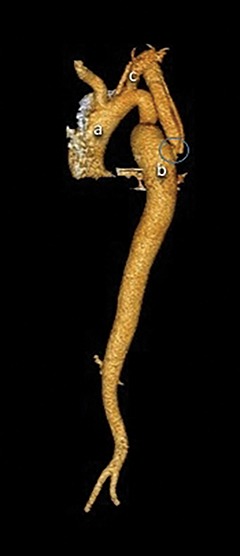Spontaneous pseudointimal graft dissection in a patient with coarctation of the aorta
Images


CASE SUMMARY
A 45-year-old male with a past medical history significant for chronic chest pain syndrome and a past surgical history significant for a coarctation repair 14 years prior. The coarcation repair was performed using an 18mm Gelweave bypass graft between the descending thoracic aorta and left subclavian artery. The patient developed graft thrombosis one year ago and was treated with long-term anticoagulation.
On presentation, the patient complained of acute substernal chest discomfort radiating to his back. Vital signs and physical exam were normal. There were no pulse deficits or radio-femoral delay. A CTA revealed a dissection flap involving the synthetic graft without evidence of graft thrombosis.
The patient was treated conservatively with B-Blockers and continuation of his anticoagulation medication. One month later, the patient returned with similar substernal chest pain. Repeat CTA demonstrated patent graft with chronic dissection. The patient was scheduled for evaluation of his graft at an outside facility.
IMAGING FINDINGS
CT angiogram was obtained (Figures 1 and 2), which demonstrated coarctation of the aorta and bypass graft between the left subclavian artery and the descending thoracic aorta. A dissection flap within the graft was noted along its entire length with equal contrast opacification of the true and false lumens. No evidence of graft thrombosis. Additionally, there was narrowing of the side-to-side anastomosis of the graft with the aorta (Figure 2). This narrowing was stable on comparison to prior imaging.
DIAGNOSIS
Spontaneous pseudointimal synthetic graft dissection
DISCUSSION
Post-coarctation graft complication includes pseudoaneurysm, true aneurysm, late graft rupture, fistulization, and graft stenosis.1 One report has described pseudointimal dissection in a Dacron graft leading to re-coarctation, which was managed surgically.2
Current literature lacks adequate research surrounding synthetic graft dissection. Intimal hyperplasia along with a secondary insult predispose patients to synthetic graft dissection.3 Graft dissection may be spontaneous or secondary to blunt trauma. Spontaneous dissection of the neo-intima has been described in a porcine-valve Dacron conduit utilized in surgical correction of various congenital cardiac anomalies.4 Shigematsu et al, discussed a non-anastamotic stenosis of a knitted Dacron graft following a repeated ilio-femoral bypass surgery. The short segmental stenosis was attributed to a pseudointimal dissection as a result of intraoperative clamping of the graft.3
Large vessel reconstruction using synthetic grafts causes alteration in the reflexes of the systemic cardiovascular function. For instance, Dacron is 24 times stiffer than healthy aortic arch tissue. The mismatched compliance between the two results in excessive stress at the suture line and leads to subsequent intimal hyperplasia.5
Intimal hyperplasia is a well recognized cause of delayed graft failure. It is a physiologic response to vascular irritation resulting in an abnormal proliferation and migration of smooth muscle cells and extracellular matrix accumulation. This response is commonly seen at the distal anastomosis. High oscillatory shearing during systolic phase, platelet derived growth factor, and release of mitogens from leukocytes, smooth muscle cells, and endothelial cells are the contributing factors. The endothelialization acts as a trigger for smooth muscle proliferation in the underlying layer.6,7 Intimal hyperplasia has also been recognized in autologous vein grafts. This phenomenon, however, is a sequel of arterialization of the graft.3
CONCLUSION
We report an unusual graft complication, a pseudointimal graft dissection in a patient after repair of coarctation of the aorta. While extremely rare, this case highlights that synthetic grafts can dissect their pseudointima. Intimal hyperplasia can extend beyond the anastomotic site, as suggested in our case where the dissection flap spans throughout the graft. This complication should to be considered in evaluation of patients with synthetic grafts.
REFERENCES
- Troost E, Gewillig M, Daenen W, Meyns B, Bogaert J, Van Deyk K, Budts W. Behaviour of polyester grafts in adult patients with repaired coarctation of the aorta. Eur Heart J. 2009 May;30(9):1136-1141.
- Kalkat MS, Thorne SA, Guest P, Bonser RS. Management of re-coarctation due to prosthetic graft pseudo-intimal dissection. Interact Cardiovasc Thorac Surg. 2007 Feb;6(1):83-84.
- Shigematsu K., Shigematsu H., Nishikage S. et al. Non-anastomotic midgrafts stenosis of a knitted Dacron graft after arterial reconstruction. Report of a case. International Angiology. 2001 September;20(3):248-250.
- Hokken RB, Spitaels SE, Hagenouw RR, Bogers AJ. Dissection in a right-sided porcine-valved Dacron conduit. J cardiovasc Surg (Torino). 2000 Feb;41(1):57-59.
- Spadaccio C, Rainer A, Barbato R, Chello M, Meyns B. The fate of large-diameter Dacron® vascular grafts in surgical practice: are we really satisfied? Int J Cardiol. 2013 Oct 12;168(5):5028-5029.
- Elsharawy MA, Naim MM, El-Daharawy MH, Shekidef MH, Ahmed IH. Effect of anastomotic length on the development of intimal hyperplasia in the distal anastomosis of bypass graft. Vascular. 2010 Sep-Oct;18(5):256-263.
- Margolin DA, Kaufman BR, DeLuca DJ, Fix PL, Graham LM. Increased platelet-derived growth factor and intimal thickening during healing of Dacron grafts in canine model. J Vasc Surg. 1993 May; 17(5):858-866.
Citation
S J, M R, P K.Spontaneous pseudointimal graft dissection in a patient with coarctation of the aorta. Appl Radiol. 2017; (1):30-31.
January 11, 2018